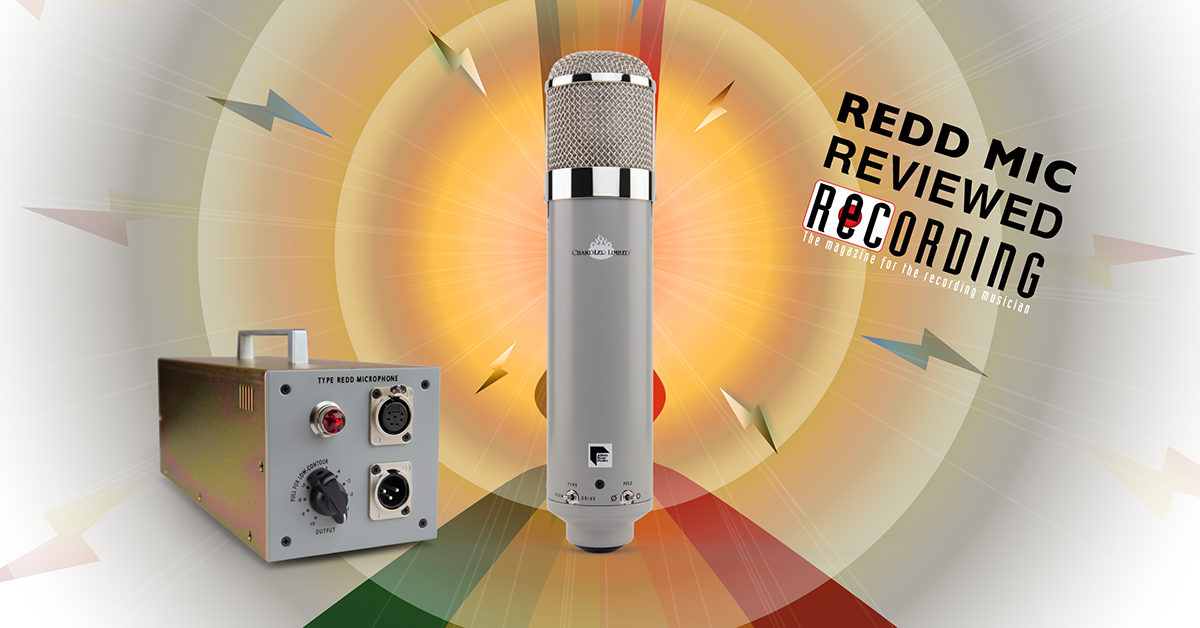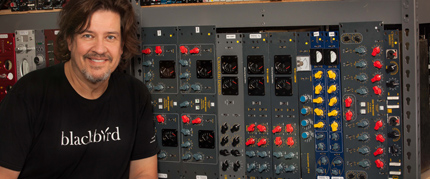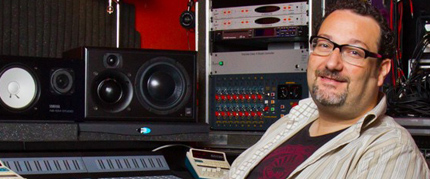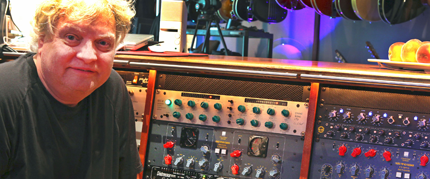 A groundbreaking debut mic from a famed builder of vintage-style gear
A groundbreaking debut mic from a famed builder of vintage-style gear
Review by: By Paul Vnuk Jr.
Recording Magazine
January 2017
For over a decade Wade Goeke and Chandler Limited have been resurrecting and expanding on the classic gear designs found within the hallowed walls of EMI’s Abbey Road studios... none of which has ever been commercially available before. This includes the solid-state TG series, the Zener-based mastering lineup, and the recent REDD.47 mic preamp and RS-124 mono tube compressor (reviewed January 2015 and February 2016).
Handbuilt in Shell Rock, Iowa, Chandler gear balances sonic authenticity with updated features for the modern studio. Now Chandler Limited, in partnership with Abbey Road Studios, has launched the first brand-new microphone in the EMI stable since the 1930s.
The new EMI LTD Type REDD Microphone is not a clone of any pre-existing classic model. The mic has a dedicated head amp/preamp that’s based on the classic REDD.47 pre and is actually built into the mic and its power supply. It also offers distinct tone shaping options which turns it into two mics in one.
Before we start, a quick disclaimer. Because this design is patent pending, Chandler Limited is not releasing specs, graphs or component-level details at this time. I have examined the mic inside and out, used it in sessions, and will tell you what I know and have heard. If you are hoping for SPL levels, frequency curves, tube and transformer details, and the like, I apologize for disappointing you.
Let’s meet the big guy!
Visually the REDD mic is similar in diameter, style and appearance to a classic Neumann U47. Dressed in EMI’s classic battleship gray, the aluminum bodied mic measures 10.75” from stem to stern with a 2.2” diameter. This makes it 1.25” taller than a long-bodied U47.
The mic comes in a kit with a specially made Pelican-style case and rigid cut foam. According to Chandler’s Adam Fiori, it was important to have a case that could withstand air travel, including being a checked item. The mic, power supply, felt-lined shock mount, screwdriver (see below), 7-pin Mogami mic cable, and AC cable all fit snug and secure inside.
Behind its chrome-plated brass head basket, the capsule assembly glows a gentle red via an internal LED. This idea is similar to lighted capsules by companies such as Korby, Cathedral Pipes, and Heil Sound. It is bright enough to see the capsule silhouette , but not so bright as to be blinding or annoying, and it lets you know that the mic is on and functioning.
Mic control
The mic contains four 2-position toggle switches and one 9-position stepped switch. Just under the head basket are a pair of recessed switches that require the aforementioned screwdriver to switch.The left switch is a 10 dB pad and the right switch changes the microphone’s polar pattern from cardioid to omni.
On the bottom of the microphone, above its bottom bell are the pre-amp controls. One is a Pole (Phase/Polarity) switch, and the other is Drive. Drive is similar to the fine gain control of the REDD.47 preamp, but rather than being a variable control, this is the fine gain fully on. It adds a bit more bite, hair, and a euphonic edge to the signal. Note this is not an overdrive or distortion; it’s more subtle and harmonic in nature. On the back of the mic is the stepped preamp input knob which goes from +4 to +33 dB, in 4 dB steps up to 24 and 3 dB steps above that.
Inside
Inside the mic are a pair of New Old Stock tubes—the names have been burnished off as part the mic’s mystery. It might be easy to assume that one is for the preamp and the other for the microphone, but due to the commingling of the circuit design, it’s not that simple. The through hole, handwired circuit board design is beautifully done, complete with gold traces and the REDD, EMI and Chandler logos embossed in gold. It also features a custom wound transformer on the output stage.
Unlike a standard tube mic power supply, the REDD microphone’s power supply is an integrated extension of the preamp design. On the back of the power supply is a black power switch and cable socket (my early unit had the switch on the front). On the front are XLR and 7-pin mic I/O as well as a fully variable –10 to 0 output attenuation knob, just like on the REDD.47 preamp. A red jewel power indicator just like the REDD.47’s will be added to production units.
The attenuator knob has a secondary feature labeled “Pull For Low Contour” which, when the knob is pulled out, out turns on the Low Contour. Interestingly the mic lacks a highpass filter (or Rumble Filter in REDD.47 speak). Instead Wade has implemented a unique circuit that tonally changes the microphone’s entire sonic profile. I don’t know what it’s doing under the hood, but it opens up the low end and excites the top end thrust of the mic in a gentle airy way.
The REDD mic is handmade in Shell Rock with almost entirely American-sourced parts, many of which are fabricated in Iowa. This includes all metalwork on the body, the circuit board and transformer, and the head basket. The only exception is the capsule, which is made in Europe.
The capsule is similar in size to most standard K47 and CK12 capsules and is a 1.25” dual backplate design with a 1” platinum-sputtered membrane. It is custom-built to Wade’s specs and uses a classic brass ring center-terminated design, rather than the more common (and less expensive) plastic ring designs.
In use
I was sent serial number 12 for review, and I have so far used it on cajon, percussion, vocals (sung and voiceover), and acoustic guitar. Using the preamp-equipped mic direct into my converter posed no problems; this mic is very clean with a low, low noise floor. It also works fine with the output lowered, run into additional preamps for added tonal color.
In its dafault state, this mic is thick and full with just a hint of darkness, yet it also yields great clarity. There is nothing modern, bright, or thin about the non-contoured REDD Mic. With Low Contour engaged, the sound opens up considerably with more mid punch, a top-end touch of air, and the low end becomes less thick and pillowy, tightening up with a nice low thump.
Engaging the Drive control on either setting adds a top end grit and thrust that can easily benefit bass, snare, and guitars, but is also fantastic on vocals. Again, this is not a Nine Inch Nails vocal distortion; it’s best described as a dusty harmonic excitement of the highs.
Regardless of either setting, the magic of the REDD microphone is its depth! Whether up close or at a healthy distance from the source, it maintains its sound and fullness. It’s a stark contrast to many mics that get thin, narrow, and generally fall off quick as you move them back from the source. If you ever wanted a mic that sounded just as good at 6 feet as it does at 6 inches, this is it.
The REDD mic has a smooth proximity effect that is very pronounced right up in the grille of the mic, and then evens out quickly, but does not drop off as on many mics. This is a mic that maintains its depth and fullness from 6” to 6’ away, especially with Low Contour off. Its off axis rejection is not tight, but is very consistent on the sides; it doesn’t thin out or become muffled and boomy.
Switching to Omni opens up the sound and drops the level by a few dB. In non-contour mode, this this is one of the fullest and richest-sounding omni mics I have used. It also passes the spin test, sounding the same all the way around as the mic turns.
Road trip
After trying the mic at my studio, Wade invited me to Chandler HQ so I could hear the mic alongside his recent Vintage King-acquired AKG C12 and his Neumann M49. Both mics are fully restored and re-skinned. This also gave me the opportunity to try out multiple REDD mics at one time.
We listened to all three mics on female vocals and a Martin acoustic guitar. I need to thank Kristin Sullivan for singing take after take of the same verse and chorus for hours as we switched out mics and tried the REDD mic in every one of its possible sonic configurations and settings. Similar thanks to Chandler’s own Scott Strauser for doing the same on the Martin.
On both vocals and acoustic guitar, Wade and I were in agreement that Low Contour mode was the way to go, with or without Drive. This setting really suited Kristen’s voice and sat beautifully forward and smooth in the full mix that she and Wade had been working on. Soloing instruments from said mix also let me hear how the mic sounded on ukulele and on bass guitar through an Ampeg Convertible bass amp. Wade tracked the bass without Low Contour on, and wow, was it thick—rich in a very classic Motown way.
On acoustic guitar (and uke), overall we again preferred the Low Contour mode which cleans up the low mud of the body, especially in strumming situations. However, with the contour out it was fantastic on mellow fingerpicked as well as plectrum arpeggio takes. This is the setting I would use on a solo acoustic album, or one where the guitar is to be the central element of a production. Turning off Low Contour mode is similarly great for deeper vocals; I liked it a lot on crooner and jazz-style male vocals in my studio.
Drums
One of the main things I wanted to hear was multiple REDD mics set up on a drum kit. Thankfully, Wade eagerly obliged. We set up a trio of REDD microphones, first in a classic Glyn Johns set up with two mics on over/side overheads and the third about a foot and half in front of the kick drum in a packing-blanketed tunnel. Here I liked the full capture of the kit through the two overheads with Low Contour off, while on the kick we put Low Contour on—otherwise it was too overwhelming, thick and pillowy.
Next we put the drums behind some gobos with one mic on the kick, another at elbow height by the floor tom, aimed at the snare, and the third mic 20 feet back in the room. We mixed all three mics in mono. Here the kick was again no-contour (and we set the room mic that way too) while we used Low Contour for more focus and tightness on the close kit mic.
Listening back, I was struck by how classic and real the drums sounded with zero spot miking. I feel like now I know why vintage mono recordings have so much 3D depth on the drums (think Beatles and old Stones records) and other instruments. The mono drums just sounded amazing, deep and lifelike. Your ear never said “Wait, this isn’t stereo!”; it just worked... the sound of the drums, the luscious room bleed on the close mic, the distant room mic at a 20-30% mix. I think this is the closest I have ever come to the Charlie Watts’ “Honky Tonk Woman” kick sound.
Comparing the REDD to Wade’s vintage mics, I was able to quantify three things. First, a well-maintained real C12 is not as bright as the Internet forums lead folks to believe. It’s actually a very tonally rich microphone, as is the Neumann M49. Second, vintage mics are really noisy compared to the very quiet REDD mic. Third, while many clones get close in EQ curve and tone, they often lack the depth, dustiness, and layers of dimensional fullness that high-end classic mics can offer. The REDD microphone has this depth and dimension.
Conclusions
The EMI LTD Type REDD carries a healthy price tag, but you get a mic (sonically two mics!) and a fantastic preamp for your money. If this mic does not become a modern classic, I will be shocked. It is 100% deserving of the EMI name, and Chandler and Abbey Road should be proud. I’ll take two!
Price: $4,499
Another Chat With Chandler Limited’s Wade Goeke
So, when did you first decide to build a microphone and why?
Wade Goeke: Well, to me there has always been a mystique about microphones, a voodoo, more so than most other gear. It’s something I’ve always had at the back of my mind to do.
Do you have a history building or repairing mics?
I’ve fixed and repaired my own for years, but about six years ago was when I started experimenting with building my own. Actually I started experimenting with the mic and the preamp combination idea right at the beginning.
Are there benefits that you’ve found in having the mic and the preamp together?
Sonically the transmission is really pure, it feels like you’re getting really close to the source. The mic itself is super-sensitive. In one of my sessions with Kristin Sullivan, I had her stand still and be quite for a few seconds so I could hear the noise floor of the mic, and while she was standing still I could actually hear her blink through the mic.
Blink?
Blink. I could hear her eyelids move.
That’s creepy.
I mean obviously it was on a close vocal, not like five feet away or anything. But I think that part of that is to do with the close proximity of the capsule directly to the amplification.
This seems like one of those ideas you’d think that somebody else would have come up with this in the last 100-plus years of mic design. Why do you think you’re the first person to?
I don’t really know, it seems like an obvious progression. I mean, mics became solid-state with smaller power circuits, smaller voltages, smaller current, until they got down to one FET transistor buffering the capsule and that’s all. I guess this is a reverse progression of that.
What were some of the challenges that you had to overcome?
Obviously, thinking of how the whole circuit was going to fit in was a big part, and the capsule choice. I tried every capsule under the sun and we ended up going with a custom capsule in the end that met my needs more than any pre-existing CK12 or K47.
Did you learn anything unexpected?
Yes: microphone circuits are very specific and overly sensitive. You breathe on them differently from one day to the next, and the circuit sounds different. I don’t mean from a performance point of view, but how you set up the capsule and the circuit matters more than anything I’ve ever come across, and that’s what I loved about it.
So the REDD.47 preamp is two rack spaces... how did you fit it into a mic?
Well, it is different because it’s a microphone, but the basis of the circuitry is the REDD preamp. I started with that circuit and I built the microphone around it. So there are no shortcuts, no weirdness, and no gimmicks going on; we’re not trying to pull the wool over anyone’s eyes; they do have physical differences.
You’re the only person that can answer this: if you were to take your mic without the built-in REDD preamp and plug it into one of your REDD rack pres, would you be getting the same sound?
It’s more complex than that. I think it’s easy to overthink something like this. You can’t really think of them apart from one another. Its all meant to function together and sound the way it’s been designed to sound as one thing.
Let’s talk about the capsule. Is it based on a CK12-style capsule, a 47-style capsule, an M7...?
It’s not meant to reproduce any of those. I think that people have just gotten into the frame of mind that there are only so many capsules available. When I first started out, I tried all of the usual suspects. I started with two vintage K47 capsules, as well as a vintage CK12 and a vintage M7. Then I started buying as many remake capsules as I could. For a long time I used an M7, but it just wasn’t doing it for me. I used a CK12 in a number of versions—that wasn’t doing it for me, either. So I decided on designing my own capsule.
You let me hear one of your CK12 prototypes... I think you made the right choice!
Thanks! That’s also why I chose the platinum diaphragm. It has a smoothness that I really like. It’s meant to be a pretty thick-sounding mic, but also maintain a brightness in presence.
I was shocked that the capsules alone are $500 each!
Well it’s European and it’s handmade. We have forty-some capsules sitting waiting to go into our next batch of mics. That’s like $25,000 sitting there in this little bitty box.
You mentioned the European capsule and I know you guys make the mics by hand at Chandler HQ. Are the parts sourced locally?
Yeah, as much as possible. The bell is machined fifteen minutes from our town and it is a specific design I did to surround the XLR connector. It cost several thousand dollars just to have a guy do drawings, work with me on the layout, and then have some machined up. The bodies are milled here in Iowa. The chrome plated brass capsules are custom made as well. There’s obviously ones you can go buy off the shelf, but it just did not seem appropriate.
Had these metal shops ever done microphones before?
No, they think we’re weird. [laughs]
What can you tell me about the inside?
The circuit board is all gold traces. Most circuit boards are tin and/or copper, and gold is considered the best transmitter. High-quality test gear, for example, has gold traces. It’s just something where I wanted to spend a little extra and make it as sweet as possible.
I know it’s one of the things that no one’s ever really gonna see, but one of my favorite things was on the circuit board. I loved the Chandler logo that’s embossed inside.
Yeah, and there’s an EMI logo on there. For me it adds to the whole thing; it’s like every detail is the best it can be.
How did you decide to add the Low Contour feature, which I know was just added a few weeks ago?
It just came about through use. I’d done a lot of work on things like drum kit, kick drum, room mics, and I tuned the mic to make sure it could capture those correctly and be large-sounding and full. And then I was like, “Oh, it’s pretty big now...do I want it that big when I do acoustic and vocals?”
To my ears, the low end opens up, but it doesn’t go away and get thin, and the high end just kind of leaps out at you a little more... a little more air.
That’s exactly what I wanted, especially for a vocal application. And on things like acoustic guitar, low frequency can be a detriment. So it’s meant to be an A/B switch, like a second preset to make the mic sound different. Then you combine that with the Drive, and you can take it even further.
The Drive is more inspired by the preamp, obviously.
Yes, that’s a little more straightforward. It’s like the fine gain control on the preamp to make it a little more hairy; basically it’s like turning the drive all the way up on the preamp. But because it’s so directly associated with the microphone and the capsule and all that, there’s a slightly different impact to it. It’s not gain, it’s more of a color thing.
With two tubes in one mic body, did you have any problem with heat buildup?
No, it gets a little warmer, but a lot of the hot components other than the tubes are in the power supply and I haven’t seen any issues.
It’s really bold to create EMI’s first new mic in 90 years. What was their response—obviously you voiced the mic with input from them?
I’m super lucky that they’ve liked it from the beginning. They have six versions, including other capsules and things, and as we went down the path there was a lot of great back and forth.
They have a mic locker that we’d all dream of...
Yeah, that was the first thing I knew right away... that they were going to pull out the old mics that were probably all used on The Beatles and the Pink Floyd stuff. It was a little scary, but I tried not to think about that too much.
Have they even heard the Low Contour yet?
No. They have not. Are you going to print that?
That means I’m cooler than Abbey Road.
You should put that in there, that’s funny. [laughs]
So what’s next for Chandler? Do you think we’ll see a solid state version of the mic?
We’ve talked about different stuff. I have experimented with a bunch of different versions, including solid-state versions as well. I don’t know what to say right now. If it turns out right, I’d like to do something, you know? A solid-state mic could definitely be made a lot more affordable than a tube mic, and so it’s something I’d like to do. And then, yeah, we definitely have more Abbey Road projects going on. I’d hate to promise anything, ‘cos we have a lot of different things in the works...
Well, I’ve seen a couple of them and you have some really cool stuff in the pipeline.
Shhh, don’t tell anybody! [laughs]
Impressions from Mirek Stiles, Abbey Road’s Head of Audio Products
Do you remember what your initial thoughts were when you heard Wade’s combined mic/preamp idea?
Mirek Stiles: I remember thinking what a unique idea it was, and started wracking my brains as to if anyone had done it already. It was one of those situations where you think it’s such a good idea, someone must have done it already. Turns out they hadn’t.
When the mic came to fruition and arrived for testing, what were some of your first impressions?
It was big! [laughs] The initial prototypes were massive. Wade managed to condense everything down quite considerably by the third generation of prototype, and the final version looks stunning. It’s built like a tank and reminds me of that old classic EMI gear that was so well made. It’s a solid workhorse of a microphone, but also very elegant.
What have you used them on, and what have been some of the engineers’ initial reactions?
We initially just tried them out on a bunch of stuff like piano, drums, brass, and strings, to get our bearings. The Abbey Road engineers gave feedback on sound and made some feature requests. The third-generation prototype found its way onto a Sting vocal session alongside our trusty classic U47s and C12s—the REDD came out on top.
After a few more feature tweaks, it’s found its way on many other vocal, guitar, and orchestral recordings. It just adds this amazing sense of depth, clarity and character to whatever you throw at it. All the engineers were very happy to use it on all sorts of sessions, even when still at the prototype stage.
How do they compare, if at all, to many of the famous mics in the Abbey Road collection?
We have one of the world’s biggest working microphone collections, obviously with some classics going right back to the 1930s. So the REDD was up against some pretty stiff competition. Obviously you have different tools for different jobs, but the REDD really does excel in most scenarios against any of the best, and then some.
How do you feel about this being the first new official EMI microphone in decades?
We have a few old classic EMI-badged microphones in our collection, including the RM1B and the HB1E. Both sound beautiful, even to this day. To hold in my hands the first EMI-badged microphone since the 1930s was pretty amazing. Especially since it’s augmented by the Abbey Road and Chandler logos.
We are all very proud of this microphone. The end result, really is a thing of beauty that I think is a real game-changer in the otherwise quite traditional world of microphones. It will become a classic in its own right. Helping Wade develop his idea was a lot of fun and an absolute pleasure—he’s a very creative and talented guy.
















